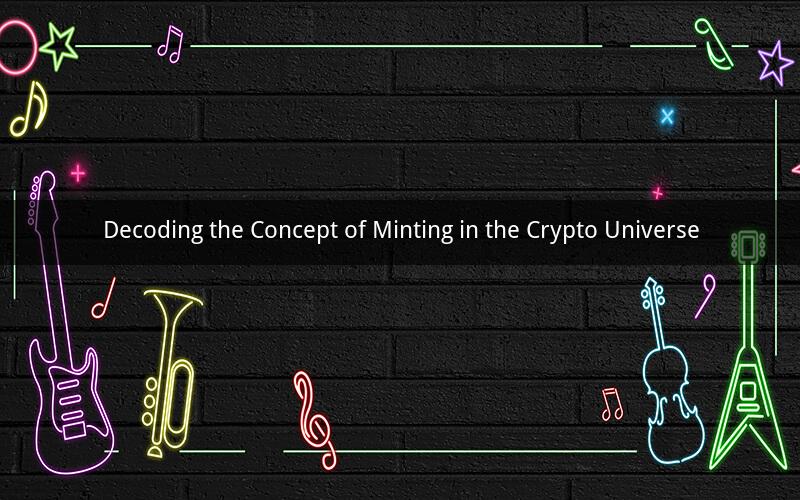
In the ever-evolving world of cryptocurrencies, the term "minting" has gained significant attention. But what exactly does minting in crypto mean? This article delves into the intricacies of minting, its significance in the crypto ecosystem, and its various applications. Let's explore the fascinating world of minting in crypto.
Minting in crypto refers to the process of creating new digital assets or tokens. These tokens can be used for various purposes, such as representing ownership, utility, or value. The process of minting is essential for the growth and development of the crypto ecosystem, as it allows for the continuous creation of new tokens that can be used for a wide range of applications.
How Minting Works
Minting is a fundamental process in the crypto world, similar to mining in traditional cryptocurrencies like Bitcoin. However, the process differs in several aspects. In the case of Bitcoin, mining involves solving complex mathematical problems to validate transactions and add new blocks to the blockchain. In contrast, minting involves creating new tokens or assets without the need for mining.
The process of minting typically involves the following steps:
1. Token Creation: The first step in the minting process is the creation of a new token. This can be done using various blockchain platforms, such as Ethereum, Binance Smart Chain, or Polkadot.
2. Smart Contract Deployment: Once the token is created, a smart contract is deployed on the blockchain. The smart contract defines the rules and regulations for the token, including its supply, distribution, and usage.
3. Token Distribution: After the smart contract is deployed, the new tokens are distributed to the token holders. This can be done through airdrops, private sales, or public offerings.
4. Token Usage: The newly minted tokens can be used for various purposes, such as paying for goods and services, participating in decentralized finance (DeFi) applications, or investing in new projects.
Significance of Minting in Crypto
Minting plays a crucial role in the crypto ecosystem for several reasons:
1. Token Supply: Minting allows for the continuous creation of new tokens, which helps in maintaining a healthy token supply. This is especially important for projects that require a steady flow of tokens to support their operations.
2. Project Growth: Minting enables projects to expand their token ecosystems by creating new tokens for various purposes. This can help in attracting more users, investors, and partners, thereby fostering growth.
3. Innovation: Minting encourages innovation in the crypto world by allowing developers to create new tokens with unique features and functionalities. This can lead to the development of new applications and services that can benefit the entire ecosystem.
Applications of Minting in Crypto
Minting has various applications in the crypto world, some of which include:
1. DeFi: Minting is widely used in decentralized finance (DeFi) applications, where new tokens are created to represent ownership, lending, and borrowing. This helps in facilitating various DeFi services, such as yield farming, liquidity mining, and stablecoin issuance.
2. NFTs: Non-fungible tokens (NFTs) are created through the minting process. These tokens represent ownership of unique digital assets, such as artwork, music, and collectibles. Minting NFTs allows artists and creators to monetize their work in the digital realm.
3. ICOs and STOs: Initial Coin Offerings (ICOs) and Security Token Offerings (STOs) involve minting new tokens to raise funds for projects. Minting enables startups and companies to raise capital without the need for traditional financial intermediaries.
4. Cross-Chain Interoperability: Minting can facilitate cross-chain interoperability by creating tokens that can be used across different blockchain platforms. This helps in breaking down barriers between different ecosystems and promoting a more interconnected crypto world.
Frequently Asked Questions (FAQs)
1. What is the difference between minting and mining?
Minting is the process of creating new tokens, while mining involves solving complex mathematical problems to validate transactions and add new blocks to the blockchain.
2. Can minting be used for creating any type of digital asset?
Yes, minting can be used to create various types of digital assets, such as fungible tokens, non-fungible tokens (NFTs), and security tokens.
3. Is minting a secure process?
Minting is generally considered a secure process, as it is based on blockchain technology. However, it is essential to ensure that the underlying smart contract is secure and free from vulnerabilities.
4. How can I mint a new token?
To mint a new token, you need to create a token on a blockchain platform, deploy a smart contract, and distribute the tokens to the token holders.
5. Can minting be used for illegal activities?
Yes, minting can be used for illegal activities, such as creating tokens for scams or money laundering. It is crucial to use minting responsibly and ensure that the tokens are used for legitimate purposes.
In conclusion, minting in crypto is a vital process that allows for the creation of new digital assets and tokens. Understanding the concept of minting is essential for anyone interested in the crypto world, as it plays a significant role in the growth and development of the ecosystem. By exploring the various applications and significance of minting, we can appreciate its importance in the crypto universe.